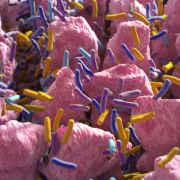
Microbiome
The microbiome is the collective name for the trillions of bacteria and other microorganisms that normally live peacefully in and on humans (the skin and the gut are major reservoirs), and many of which, through their rich array of genes, perform functions that support our existence in diverse ways. There are said to be 100 trillion bacteria residing in the gut alone. Some of them help humans digest the sugars in cow’s milk; there are others that break down dietary fiber and, in the process, release metabolic byproducts that influence immune status, nervous system, and every other operating system of the body.
Although it’s always been with us, the microbiome has only recently become the subject of serious study for the contributions it makes to human health and disease. Research shows that bacteria in the gut not only aid digestion, but they are also a major defense against infection, they powerfully affect overall immune function, and, perhaps most surprising, they directly and indirectly affect brain function and mood.
There are thousands of species of microbes that normally inhabit the gut. Many are acquired at birth, during passage through the birth canal, and then by breastfeeding. Others come from the environment around us. Still others arrive via the food we eat. Those that contribute to human health are known as probiotics, sometimes just called “good bacteria.”
Research demonstrates that diversity of the gut microbiome is strongly associated with mental and physical health; lack of diversity turns up in disorders from Alzheimer’s disease and anxiety to vascular disease and type-2 diabetes. The composition of the gut may even play a role in the response to medication and contribute to a lack of effect in many cases.

A major function of the gut microbiome is to protect you from disease-causing bacteria that try to hitchhike their way into your system on food. Starting with your mouth, the digestive system is a major portal through which pathogens enter the human body. Perhaps you’ve even received a phone call from your local supermarket advising you not to eat those onions you bought, because they may be tainted with the food-poisoning pathogen Salmonella. The resident bacteria in your gut are the first line of defense against such infection (after your vigilant grocer).
It is because of beneficial bugs in the gut that we can get some extraordinary substances from foods. Of the hordes of bacteria in the digestive tract, very few of them live in the acid environment of the stomach, which breaks down food and prepares it for digestion. A small number of them reside in the small intestine, where much of food digestion takes place. The vast majority of gut bacteria inhabit the large intestines, the colon.
There, they tackle foods that are resistant to digestive enzymes—notably foods rich in the complex carbohydrates known as fiber. From them, they create micronutrients that boost health in ways that are still under study. They also aid in the digestion of protein and, to some extent, fat. In the process of digesting foods, gut bacteria release a great array of molecules known as metabolites that have effects on virtually every system of the body. The actions of the microbiome extend well beyond the gut.
Gut bacteria play a significant role in stimulating the growth of the immune system and regulating its activity. One way they do it is by maintaining the integrity of the cells lining the gut; they prevent escape into the bloodstream of any microbes or toxic substances that might otherwise leak out and cause chronic systemic inflammation, a contributor to disorders ranging from inflammatory bowel disease to depression. Dysfunction of the gut barrier, a condition known as “leaky gut,” is linked to autism in ways still not understood.
The composition of the microbiome also directly influences immunity. Animal studies show, for example, that the presence of specific beneficial bacteria in the microbiome (Akkermansia is one type) can tamp down the activity of immune cells responsible for inflammation in the brain. Having a vibrant population of Akkermansia in the gut may help people resist frailty in aging. Other beneficial bacteria have been shown to lower levels of a type of inflammatory cells known as cytokines.
Among the many things gut bacteria do is they synthesize substances that are psychoactive, including some of the same neurotransmitters that relay messages in the brain: serotonin, dopamine, norepinephrine (noradrenaline), and GABA. That allows them to “speak” to the brain directly and indirectly, influencing its operations. For these reasons, the gut is sometimes called “the downstairs brain.”
The neurotransmitters released by gut bacteria may act on the many nerves present in the gut; they also can enter the bloodstream and get carried by it to the brain. They also communicate with the brain via the vagus nerve, a bundle of nerve fibers directly connecting the brain and the gut and powerfully influenced by stress.
The many ways the gut communicates with the brain is called the gut-brain axis. Gut bacteria produce many other substances besides neurotransmitters that influence brain function. For example, they release compounds that affect the permeability of the blood-brain barrier that normally shields the brain from toxic agents. Other substances gut bacteria release stimulate the production of biochemicals that enhance memory and other cognitive processes.
Yet other gut biome derivatives, such as short-chain fatty acids, released through the digestion of fiber-rich foods, act as signaling compounds in the nervous system and ultimately affect both the growth of new nerve cells and the flowering of nerve cell connections, literally paving new pathways out of conditions like depression. The gut-brain axis is increasingly seen as channel for influencing mental health and, potentially, treating many forms of mental distress.

There are thought to be somewhere between 1,000 and 1,500 species of bacteria residing in the gut. The composition of the microbiome varies somewhat from person to person, but in each individual is relatively stable. That, however, does not mean it is static; it changes in response to what we do, where we are, and, especially, what we eat.
For example, engaging in physical activity has been found to favorably alter the composition of the microbiome. Stress disturbs the balance of bacteria in the gut. Taking medications, especially antibiotics, and especially during childhood, kills off many beneficial bacteria in the gut, and while they recover slowly, some may never return.
Bacterial diversity is considered a hallmark of wellness, important for maintaining a generally healthy physiological state. It is associated with many health-related measures—positively associated with height, physical activity, fruit and vegetable consumption (especially the cabbage family), even caffeine consumption.
The most abundant bacteria in a healthy gut belong to a family called Firmicutes; they have been shown to make up about 80 percent of a well-balanced microbiome. Another prominent family of bugs in the microbiome is Bacteroidetes, constituting about 15 percent of a balanced microbiome. The relative proportion of Bacteroidetes to Firmicutes is thought to drive gut bacterial diversity.
Other players in the healthy gut biome include:
Prevotella
Bifidobacterium
Lactobacillus
Eubacterium
Roseburia
Faecalibacterium
Veillonella
Research suggests that there is not one single microbiome profile that is optimal, as many species of beneficial bacteria with overlapping functions likely compete with each other to gain a place in the gut ecosystem. Instead, a “healthy gut” can encompass an array of microbiome states with differing sets of beneficial bacteria.
The lack of a diverse array of bacteria in the gut is a condition referred to as dysbiosis. It is negatively associated with body weight, body mass index, triglyceride and LDL cholesterol levels, insulin resistance, and blood pressure. It is increasingly viewed as a marker for many health disorders.
Dietary habits strongly influence the microbiome. Studies show that the foods people eat can influence the overall variety of bacteria in the biome as well as affect the growth of specific strains of bacteria that are neurally active. Moreover, it takes only a couple of days for diet to begin to have an effect on the makeup of the gut microbiome.
Some foods directly affect the microbiome in health-promoting ways. They contain strains of bacteria that promote microbiome diversity or that produce substances known to favorably affect specific body systems. They are called probiotics, and in addition to being available naturally in some foods—yogurt is one—probiotic bacteria are widely available compounded into diet supplements. Fermented food—sauerkraut, kimchi, hard cheeses—are all naturally probiotic-rich.
Other foods—called prebiotics—promote the growth of good bacteria in the gut and help maintain healthy diversity. They are rich in specific types of fiber—inulin, beta-glucans, fructo-oligosaccharide (FOS), galactooligosaccharides (GOS)—that feed specific types of gut bacteria. Our bodies are built for prebiotics, and they are found in such foods as oats, barley, shiitake mushrooms, seaweed, beans, onions, and garlic.
Foods that are heavily processed—an increasing part of the American diet—have been shown to alter the entire microbial ecosystem and make it less receptive to whole populations of beneficial bacteria. In essence, processed foods starve gut bacteria. Processing strips away fiber, rich in the complex carbohydrates that nourish various species of gut bacteria. It is linked to mounting rates of obesity, metabolic diseases such as diabetes, cardiovascular disease, psychiatric disorders, even Alzheimer’s and Parkinson’s diseases. Some scientists consider the loss of microbial species as a health threat on a par with climate change.
Emerging understanding of the microbiome spotlights manipulation of microbial diversity as a new means of maintaining health and treating disease. Current research around the world is exploring the relationship between diet, other lifestyle factors, microbiome makeup, and specific diseases. Even the speed of aging appears to be influenced by the microbiome. At some point in the foreseeable future, profiling the microbiome may become standard in medical and psychiatric care, with the aim of manipulating its makeup via changes in diet.














